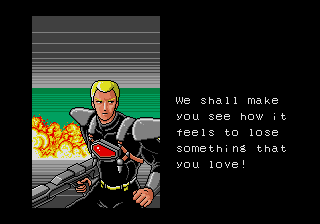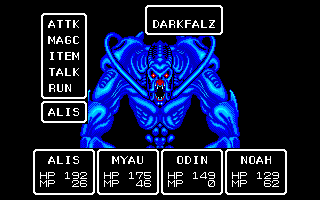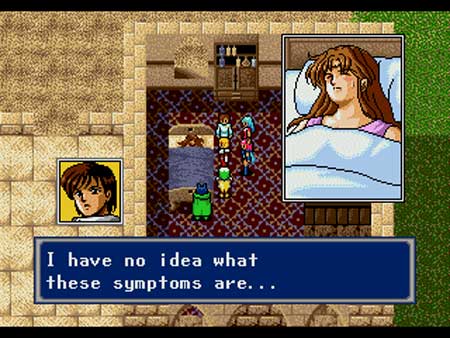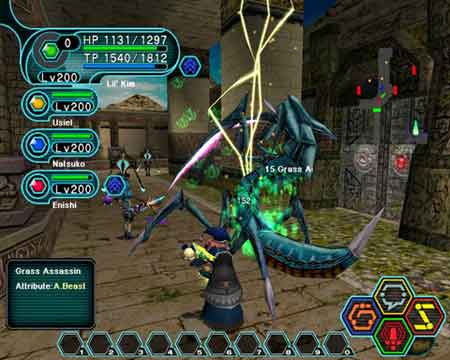Word has recently come across the FFC teletype that Phantasy Star Zero, the latest installment in Sega’s long-running series, will be arriving on western shores in convenient Nintendo DS-compatible cartridges in Q2 of this year. Once again we all have a chance to put on thigh high stockings and battle improbable monsters! Wear big blue hairstyles! Sport unnecessarily pointed ears! All the tropes we love from Phantasy Star.
The franchise has come a long way from its roots, for better or worse. Click the jump to follow Steerpike on an inevitably wordy trip down memory lane.
![]() Phantasy Star has always been a very important series to me, though that importance became less direct and more… philosophical some years ago, after Phantasy Star III.
Phantasy Star has always been a very important series to me, though that importance became less direct and more… philosophical some years ago, after Phantasy Star III.
The original, for the Sega Master System, was kind of a revelation when it came out in 1987. PC gamers were long used to menu-driven RPGs, on account of Ultima, Wizardry and many others. But console jockeys hadn’t gotten much exposure to the style. Moreover, back in ’87 the uniquely Japanese manga/anime look was also pretty new thing. Phantasy Star, intended in part as a response to the NES’s The Legend of Zelda, was not only the most technologically advanced Master System game of its time, it was among the most daring and innovative… one of those occasions when a gamble pays off.
I was twelve and I didn’t have a Master System, but I’d played the game at a friend’s house and yearned – yearned! – to go back to the Algol star system and help young Alis bring down the tyrannical King Lassic. Still, my yearnings had to wait until I bought a Genesis with money saved up from bagging groceries at Kroger (we gotta start somewhere). With the help of the Genesis Power Base Converter, at last Phantasy Star was mine. And it did something very, very few games have since: it lived up to my expectations. The game was sublime, flirting even back then with modern concepts of open-world gameplay, vehicle sequences, emotive, realistic characters and a frankly quite dark story of power’s siren song; how lust for dominance drove a formerly benevolent monarch to commit atrocities that changed a peaceful, progressive society into a fascist dystopia. Plus there was a talking cat.
And then, the end, the final moments. You and your stalwart band had finally, after a long and desperate struggle that spanned three planets, toppled the mighty King Lassic. Racing back across worlds to bring the joyous news to the one man left in Algol’s political infrastructure that you could trust and begin the slow process of rebuilding society. Down the street. Down the hall. Through the door, and
“Surprise” second bosses were an established trend by then; who among us did not watch in terror as Count Dracula, finally overcome, transformed instead into that hideous beast in Castlevania. The monstrosity you faced at the end of Phantasy Star, however, was more than just a tough opponent. Throughout the game there’d been hints that something darker lurked behind King Lassic’s sudden and thoroughly out-of-character power grab: something wicked and malicious that loved Algol not. Something evil.
As it turns out, it was evil. Several of the early Phantasy Star installments were finally, ultimately, reflections on evil’s living form. Every thousand years or so it would return to the Algol system and pounce on it. Its only interest was to cause torment and fear, like a not-hungry cat toying with a mouse, happily whiling away its boredom with torture, but having no real tangible goals. The Dark Force generally preferred to work through a provocateur, not revealing itself unless necessary. King Lassic served this role in Phantasy Star. In the sequel, the web of bad guys got so tangled there was some doubt about who was controlling who.
Phantasy Star II was notable for the epic sweep of its story, the immensity of its cast and environment. And if you’ll forgive my paraphrasing of an article from Play magazine here, it was also notable for
…its overwhelmingly dour tone. This was the first time [I] played a game in which a main character died, and stayed dead… as if that weren’t enough, at the end you utterly fail to save the galaxy and you and your friends are slaughtered to a man.

Maybe so, but it won’t matter.
“Dour” is the warmest word possible to describe the mood of Phantasy Star II, a game so relentlessly bleak and nihilistic that you’d expect its like from Ukraine, not Japan. Touching on themes of racism and tolerance, friendship, love, estrangement, exploitation, persecution, and greed, by the end of Phantasy Star II an entire planet, with all its requisite population, has been destroyed; the ecosystem of another devastated beyond recognition; the computer system on which the people of Algol depend for their very lives has been shut down; and the grim truth of who’s behind it all is more horrifying – and prescient – than even those tragedies. I mean sure, it’s Dark Force, but the Dark Force doesn’t generally create awful situations… instead, it takes advantage of poisons that are already rotting in the mud. And something is rotten indeed this time.
This Phantasy Star had made the transition to the glorious 16-bit Genesis, and kept the faith of the original firmly intact. One reviewer at the time said, “It’s not a game, it’s an obsession.” For all its boundless gloom, Phantasy Star II closed with just a hint of enigmatic optimism: “I wonder what the people will see in the final days?” it asked.
And on the series went from there, to the best-forgotten Phantasy Star III. The core team responsible for the first two games got the boot, and the new developers didn’t seem to grasp the majesterial importance of the Phantasy Star flavor, producing instead a merely passable JRPG in a world that – by 1990 – was overwhelmed with them. Though the Dark Force returned, it felt more like it was there out of a sense of responsibility than malice. And the action moved away from Algol, integrating instead with a surprisingly comprehensive but completely unconnected fiction of another world entirely. While gamers were excited by promises of a multi-generational game in which you controlled characters who would age, fall in love and marry, bear children and even die, we discovered in practice that this was simply a way to make you play through the game more than once. Phantasy Star III, it would seem, wasn’t there to show us what people would see in the final days.
By 1993, when Phantasy Star IV rolled around, I was in college and didn’t have the time, money or inclination to buy it. To this day I’ve never played, except once for a few minutes in preparation for a GameTap writeup. More’s the pity, because all agree that PSIV, in returning to its roots, produced a fitting close for the first half of the Phantasy Star legend. The Algol system made its return, the inevitable millennium passing between this game and the events of the previous. Dark Force – whose strange attraction to this particular star is finally explained – is back to its old tricks, and once more society must be saved.
One of the most interesting things about the Phantasy Star games is the level to which each forces you to deal with tragedy. Video games commonly begin on a revenge theme (even the first Phantasy Star kicks off with the murder of Alis’s brother). But death in games tends to be remote, removed – something either anticipated or not particularly wrenching. The deaths of important characters seem more like a tool in most games, like a switch a developer throws in hopes of eliciting a reaction from the audience. I think it’s so often clumsily used that gamers are rarely affected by it at all, simply nodding and pressing the button to move past the relevant cutscene. Thus it is when those few rare games actually make you feel a death, they’re all the more powerful for it. The Phantasy Star series extremely proficient at this, taking from you characters you genuinely cared about, people without whom the life of your in-game avatar was made meaningless. Even as you the player sat there and felt sad about it, the character in the game experienced devastation you rarely see in this medium, and that in turn made you the player feel even worse.
It has been argued – rightly, I think – that part of the reason the Phantasy Star games (the ones that matter, which is to say PSI, II, and IV) are so human, and so deft at manipulating emotion, is because they were designed and directed by a woman – Rieko Kodama. I have no idea what this might mean when it comes to differences between the sexes in narratological construction, but it’s worth noting. Female game designers, especially in leadership positions, were and are quite rare in Japan, and the global industry is generally a little short on girl power. Even now we see too few female-led games to say for sure, and development teams are too big now anyway so it’s all diluted, but it could be argued that Kodama’s contributions went well beyond simple game development. For what it’s worth, the Phantasy Star series held on to your heart.
The Phantasy Star series was hugely popular. With the Genesis waning in the mid-1990s, it seemed only logical that Sega would carry the franchise on to the next generation platform. Alongside Zelda, Final Fantasy, and Dragon Quest – all Nintendo-exclusive – Phantasy Star was one of the giants of JRPGs. But though Sega’s ill-fated Saturn did see a graphics-enhanced remake of the first three titles in a Sega Ages bundle, the time of Phantasy Star in its original incarnation had come to an end.
Sega recognized the strength of the franchise, but also saw the future of gaming: online multiplay. Well before the MMOG revolution, the company migrated its most popular RPG franchise to the next generation – this time the Dreamcast system – and made it an MMO. Phantasy Star Online wasn’t enough to save the doomed console, or the doomed company, and Sega withdrew from the hardware business, holding on to its precious IP.
The chief problem with PS Online was that while it looked (sort of) like previous Phantasy Star games, it didn’t play like one. This was due not to the incompetence of the designers but the fact that Phantasy Star was and needs to be a solitary experience. The world it spreads before you is one of profound self-reflection, of real and allegorical loss, of genuine philosophical and thematic importance. The minute you enter such a world and find yourself surrounded by people with names like “Cockbacca” and “1InchLong&ThickAsACoffeeCan,” you’re jolted out of it. In trying to make Phantasy Star into a property that would spearhead the new online movement, they ripped out the thing that made it precious.
And so one after another they failed, these online Phantasy Stars. There was PS Online, of course; a disastrous foray onto the PC side with Phantasy Star: Blue Burst, and the most recent, the Xbox 360’s Phantasy Star Universe, a game that, as though ashamed of what it was to become, attempted the best of both worlds by tacking on a pointless and derivative single-player adventure before granting access to the universe it so proudly advertised in its title. MMOGs fail all the time, and there were plenty of reasons that these did. It was a business decision to move the franchise online. A bad one, to be sure, but one that made sense at the time.
There have been other Phantasy Star titles, online and off, that I’ve missed in this rambling article – diversions onto the PSP handheld and what have you – and now there’s Phantasy Star Zero. I admit I am not a great lover of handheld gaming systems. I own and enjoy a DS; I’m playing through Chrono Trigger on it right now. But it’s not a platform I generally seek out. And since I seriously doubt that PS Zero will do anything to hearken back to the glory days of the 1980s, when Phantasy Star reigned supreme and my entire life was, to some degree, planned around it, I don’t think I’ll be picking it up. I’m already a bit off-put by the revelation that it doesn’t take place on Algol at all, but on some bizarre proto-Earth. Oh well.
Amusingly, all I intended to do with this post was announce that Phantasy Star Zero had been confirmed for U.S. release. I’m really busy at work and didn’t have time to write all this. But even all these years later, there’s still something about the call of Algol that brings a smile to my face, and I suppose that taking part of my day to revisit that amazing place is no high price to pay.
![]() Email the author of this post at steerpike@tap-repeatedly.com.
Email the author of this post at steerpike@tap-repeatedly.com.




